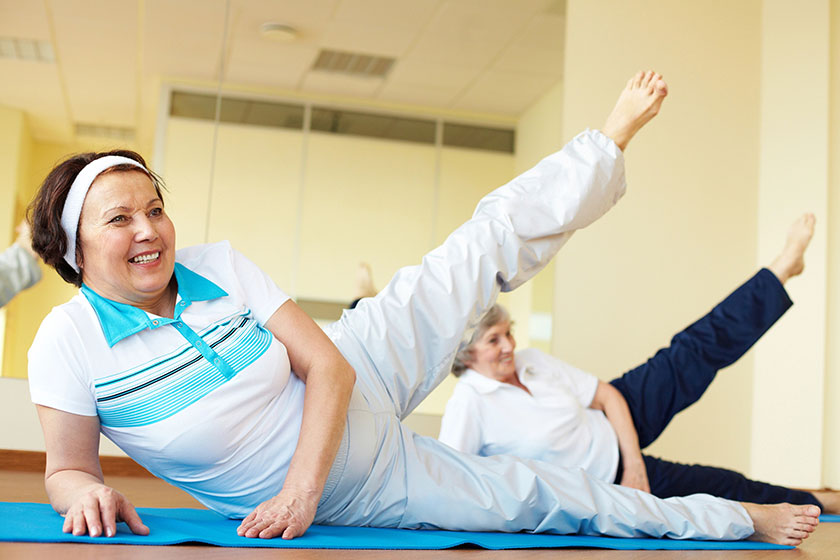As we age, maintaining mobility and flexibility becomes crucial for overall well-being. Engaging in targeted hip exercises for seniors can significantly enhance movement and reduce discomfort. These exercises are designed to be gentle yet effective, ensuring that you or your loved ones can move with greater ease and confidence.
Standing Hip Flexion
Standing hip flexion is a simple exercise that helps strengthen the hip muscles and improve balance. To perform this exercise, stand with your feet hip-width apart and hold onto a sturdy surface for support. Slowly lift one knee towards your chest, hold for a few seconds, and then lower it back down. Repeat this movement 10 times for each leg.
This exercise is particularly beneficial for older adults as it enhances hip flexibility and can be easily incorporated into a daily routine. It is a great way to start your journey towards better hip health.
Seated Marching
Seated marching is an excellent exercise for those who may have difficulty standing for long periods. Sit in a sturdy chair with your feet flat on the floor. Lift one knee as high as you comfortably can, hold for a moment, and then lower it. Alternate legs and perform 10 repetitions on each side.
This exercise not only strengthens the hip flexors; it also helps improve circulation and coordination. It is an ideal choice for maintaining hip mobility while seated.
Hip Circles
Hip circles are a gentle way to increase hip joint flexibility and range of motion. Stand with your feet shoulder-width apart and rest your hands on your hips. Gradually rotate your hips in a circular motion, creating large and controlled circles. Complete 10 circles in one direction, then change to the opposite direction and repeat.
Performing hip circles regularly can help alleviate stiffness and improve overall hip movement, making daily activities more comfortable for older adults.
Side Leg Raises
Side leg raises target the hip abductor muscles, which are crucial for maintaining stability and balance. Lie on your side with your legs straight and your lower arm supporting your head. Slowly lift your top leg as high as possible without discomfort, hold for a few seconds, and then lower it. Repeat this movement 10 times on each side.
Incorporating side leg raises into your exercise routine can help strengthen the muscles around the hip joint, reducing the risk of falls and improving lateral movement.
Hip Bridges
Hip bridges are effective for strengthening the glutes and the muscles around the hips. Lie on your back with your knees bent and feet flat on the floor. Lift your hips towards the ceiling, squeezing your glutes, and hold for a few seconds before lowering them back down. Perform 10 repetitions.
This exercise not only enhances hip strength but also supports the lower back, making it beneficial for overall mobility and stability in older adults.
Seated Hip Stretch
The seated hip stretch helps to relieve tension in the hip muscles and increase flexibility. Sit on a chair with your feet flat on the ground. Place one of your ankles over the opposite knee and gently press down on the elevated knee to enhance the stretch. Hold the stretch for 20 to 30 seconds and then switch sides.
This stretch is particularly useful for easing tightness and improving the range of motion in the hips, making it easier to perform daily tasks.
Hip Flexor Stretch
The hip flexor stretch focuses on preserving flexibility in the front of the hip, an area that tends to tighten as we age. To perform this stretch, kneel on one knee while placing the opposite foot forward, creating a 90-degree angle at the knee. Slowly push your hips forward until you feel a gentle stretch along the front of your hip. Hold the position for 20 to 30 seconds before switching to the other side.
Incorporating this stretch into your routine can help alleviate hip discomfort and improve overall flexibility, contributing to better mobility and reduced pain.
Tips for Safe Exercise
While hip exercises are generally safe, it is important to perform them correctly to avoid injury. Start slowly and gradually increase the intensity of your workouts as your strength and flexibility improve. Always listen to your body and stop any exercise that causes pain or discomfort.
It is also a good idea to consult with a healthcare professional or physical therapist before starting a new exercise routine, especially if you or your loved one have any existing health conditions. They can provide personalized advice and ensure that the exercises you choose are appropriate and beneficial.
Enhancing Mobility through Consistency
The key to improving hip mobility and maintaining flexibility lies in consistency. Incorporating these exercises into your daily routine can lead to significant improvements in how you or your family member move and feel. Regular practice helps to build muscle strength, reduce stiffness, and enhance overall mobility, contributing to a more active and fulfilling retirement life.







